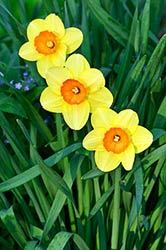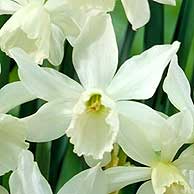Next to tulips, daffodils are among the best loved spring-flowering bulbs. Narcissus bulbs are winter hardy and easy to grow, and deer and other wildlife, including pesky squirrels, won’t touch them.
No wonder they are spring’s loveliest rays of floral sunshine.
The difference between daffodils and narcissus
 Daffodils ‘Suzy’
Daffodils ‘Suzy’
There is none: both names are interchangeable. Narcissus happens to be the botanical name for these bulb plants.
Although these terms are often used to refer to large and small-flowered forms, they are all classified in the genus Narcissus.
Daffodils, narcissi, jonquils and paper-whites are variants of the same species: all are members of the genus Narcissus. Except for Tazetta types (paperwhites) and a few wild species, modern garden narcissus are completely winter hardy.
They naturalize well and come in a variety of colors (but not true pinks yet). The most common colors are yellow, white, orange-red, orange and salmon.
Many cultivars display marked or subtle differences in color between the corona (trumpet or cup) and the perianth (petals). Double daffodils have a clustered cup, petals or both.
A succession of blooms with different narcissus
With a little planning, you can plant daffodils that provide you with blooms over six weeks. At your garden center, in catalogues or at on-line bulb suppliers, you’ll find bulbs are marked early, mid or late to indicate time of bloom.
Timing will, of course, vary depending on what kind of spring weather you get and where in the country you live. An early spring can push bulb blooms ahead, while a cool wet spring can delay flowering and then prolong it for a couple of weeks.
Early, mid- and late-season bloomers

The lovely white cultivar, ‘Thalia
Favorite early varieties include King Alfred types such as the bright yellow ‘Dutch Master’ and the pure white ‘Mount Hood’. Look for good mid-season cultivars such as ‘Ice Follies’, with its creamy white petals and a sunny-yellow cup that turns white with age, and the yellow ‘Carlton’.
Late season favorites include the fragrant jonquil hybrid ‘Quail’, which is a soft golden yellow, and the delicate ‘Actaea’, which has a yellow cup delicately rimmed in crimson.
Popular miniature, small and rock garden narcissus include ‘February Gold’ (early to mid-spring), ‘Minnow’, Thalia (mid-spring), ‘Hawera’ (late) and ‘Tête à-Tête’ (early).
Narcissus planting how-to:
When to plant: It’s best to get these bulbs into the ground early, preferably in September so they can make vigorous root growth while the soil is still warm. Once planted, the bulbs will bloom happily in the same location for many years.
Where to plant: Besides the fact that wildlife leave them alone, another great advantage of narcissi is that they can be planted in many places in the garden. Since they can tolerate both sunny and part-shade locations, they will grow well in the perennial border, the rock garden or under deciduous trees and shrubs.
- Planting depth to base of bulb: Large bulbs: 8 inches (20 cm.) deep; small bulbs: 5 inches (12.5 cm.) deep.
- Spacing between bulbs: 3 inches (7.5 cm.) apart for large bulbs; 1 inch (2.5 cm.) for small bulbs.
- Soil and sunlight requirements: These bulbs thrive in ordinary garden soils that do not hold too much water. In wet areas, the bulbs tend to rot, so choose a well-drained spot in your garden. Give bulbs full sun to part shade (at least half a day of sunshine).
- Care after flowering: Once flowering is complete, you don’t need to remove spent blossoms, but be sure to allow the leaves to remain in place until they yellow (6 to 8 weeks). Flower production for next year will suffer if the leaves don’t stay in place long enough to produce food to replace the strength lost in flowering.
- Division: Because daffodil clumps increase, every year you will have more. You can divide very large clumps of daffodils as soon as the leaves wither. Dig them up and replant the bulbs as soon as possible.
More Bulb Information
Do you forget to plant daffodils in the fall?
Why not plant potted ones in spring
What do after your bulbs finish flowering




